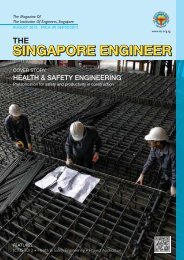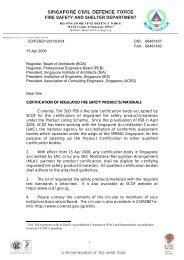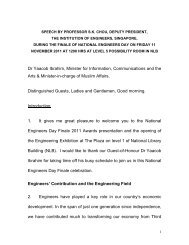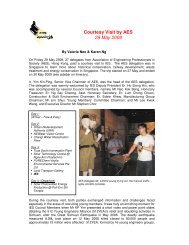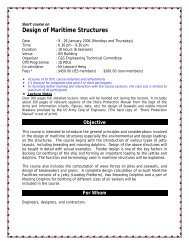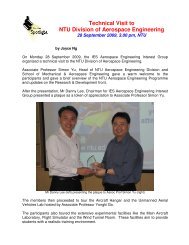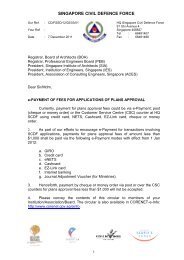THE SINGAPORE ENGINEER - Institution of Engineers Singapore
THE SINGAPORE ENGINEER - Institution of Engineers Singapore
THE SINGAPORE ENGINEER - Institution of Engineers Singapore
Create successful ePaper yourself
Turn your PDF publications into a flip-book with our unique Google optimized e-Paper software.
COVER STORY<br />
WIDE CHORD FAN BLADE<br />
MANUFACTURING FACILITY<br />
Super plastic forming process at the Wide Chord Fan Blade (WCFB) manufacturing facility.<br />
The Wide Chord Fan Blade (WCFB) manufacturing facility<br />
at the Rolls-Royce Seletar Campus is the group’s first facility<br />
outside the UK to manufacture hollow titanium WCFBs - based<br />
on unique technology that has played a key role in the success<br />
<strong>of</strong> the Trent aero engine family.<br />
This facility has been purpose-built to increase efficiencies and<br />
provide additional capacity to the group’s Barnoldswick factory<br />
in the UK.<br />
The Seletar facility is designed to simultaneously produce<br />
WCFBs for multiple Trent engine types. Initially, it will produce<br />
WCFBs for the Trent 900, beginning in mid-2012. At full capacity,<br />
the facility will be able to produce 6,000 blades per year.<br />
WCFB<br />
The hollow titanium WCFB was pioneered by Rolls-Royce<br />
and introduced into service in the 1980s. It has since set new<br />
standards in aerodynamic efficiency and resistance to foreign<br />
object damage.<br />
The blade’s hollow design allows significant weight saving<br />
<strong>of</strong> around 30% to be achieved in the fan blade, the fan disc<br />
structure, and containment features, which greatly improves<br />
performance and fuel efficiency.<br />
Moving a tonne <strong>of</strong> air per second, the fan produces over 80% <strong>of</strong><br />
the engine’s thrust.<br />
The largest Rolls-Royce WCFB currently in service is on the<br />
Trent 900 for the Airbus A380. A total <strong>of</strong> 24 blades are needed<br />
to complete one Trent 900 engine with a fan diameter <strong>of</strong> 116<br />
inches. The Trent 1000 engine for the Boeing 787 Dreamliner<br />
requires 20 blades and has a fan diameter <strong>of</strong> 112 inches.<br />
The manufacturing process<br />
In total, about 80 complex processes are involved in producing<br />
the hollow titanium WCFB, which result in their very lightweight<br />
but exceptionally strong design.<br />
The blades feature an internal structure, created through a process<br />
during which three sheets <strong>of</strong> titanium are formed, representing the<br />
two outer skins and the internal corrugated structure.<br />
An inhibitor is applied to define the internal structure before<br />
the three pieces are bonded in a high temperature pressure<br />
vessel. This is done in an ultra-clean production facility through<br />
a process <strong>of</strong> diffusion bonding, for which Rolls-Royce has more<br />
than 60 patents registered, worldwide.<br />
Finally, the blade is twisted and the cavity is inflated at a very high<br />
temperature using an inert gas in a shaped die to yield its final<br />
aer<strong>of</strong>oil shape.<br />
Using millions <strong>of</strong> data points from advanced cameras, the dimensions<br />
<strong>of</strong> each blade are measured to the accuracy <strong>of</strong> 40 microns.<br />
The WCFB is subjected to linishing.<br />
The hollow titanium WCFB is lightweight but exceptionally strong.<br />
12 <strong>THE</strong> <strong>SINGAPORE</strong> <strong>ENGINEER</strong> April 2012



